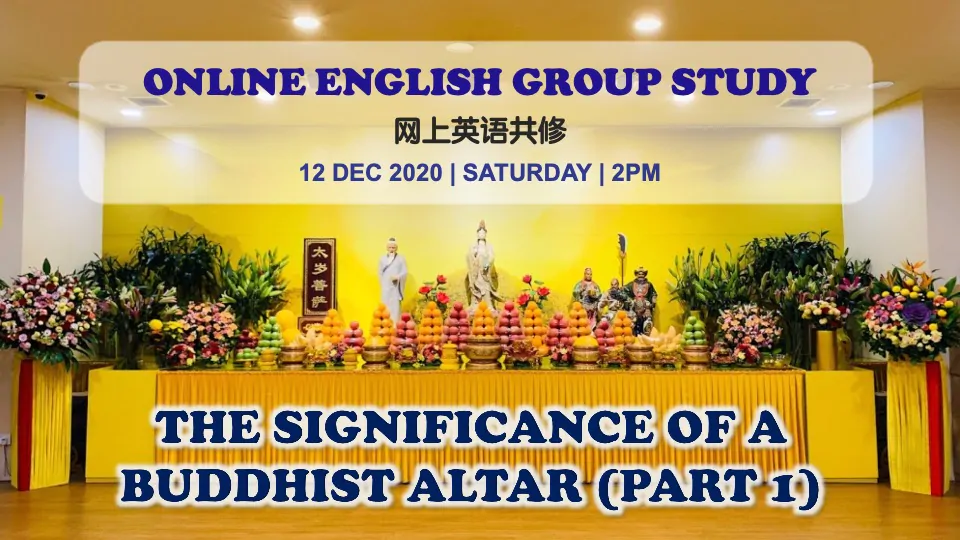Time : Saturday 2pm-4.20pm
Platform : ZOOM Cloud Meeting
Topic of Discussion : THE SIGNIFICANCE OF A BUDDHIST ALTAR
On 12 December 2020, Guan Yin Citta, Singapore held another online English Group study. Today’s session focused on the significance of a Buddhist altar.
? Did you know that:
1. The effects of offering Little Houses will be greatly improved with a Buddhist altar at home
2. A simple Buddhist altar is better than none
3. Having an altar makes a huge difference when you perform prostrations
4. Offering Heart Incense is not as good as offering real incense
5. Setting up an altar at home and helping others to do so are both great meritorious and virtuous deeds
6. Setting up a Buddhist altar generates the best feng shui
During the session, Buddhist friends learnt more about the role of the six Bodhisattvas we worship daily, allowing us to imbue our spiritual practice with more meaning.
In addition, participants also discovered new do’s and don’ts regarding Buddhist altars and praying to Bodhisattva, enabling us to be more upright and proper in our cultivation.
Through stimulating discussion, practitioners realised that this integral part of our spiritual practice serves to reinforce our faith, sincerity and devotion. As such, the key takeaway would lie less in formalities but more in the mentality of respect and reverence towards Bodhisattvas that one should adopt.
Let us now look at some comments from participants:
“My biggest takeaway is that a Buddhist altar is very important in one’s spiritual cultivation. Bodhisattva will be there any time when we need someone to speak to about everything deep in our heart. Having a Buddhist altar is just like having the temple at home, and we can plead for Bodhisattva’s blessing and help.”
?Join us in our next session
Please contact Loh SX (96978356) / Woan Yi SX (82182248) for more information
⏰ Date and time:
Saturday 19 Dec 2020 (2.oopm – 4.00pm)
Please click here to download the Summary Slides shared during the Group Study:
![]() Summary Slides_THE SIGNIFICANCE OF A BUDDHIST ALTAR_12Dec2020
Summary Slides_THE SIGNIFICANCE OF A BUDDHIST ALTAR_12Dec2020
WHAT ARE WE LEARNING TODAY?
-
The importance and benefits of having a Buddhist Altar.
-
Role of the Bodhisattvas worshipped on the Guan Yin Citta Altar.
-
Placement, Design and Arrangement of a Buddhist Altar.
-
How to Make Offerings to Bodhisattvas?
-
Process of Setting up an Altar
< THE SIGNIFICANCE OF A BUDDHIST ALTAR (PART 1) >
Myriads of Lights 万家灯火
When every household makes offerings to Bodhisattva with many lights and lamps, Guan Yin Bodhisattva will be there to save you. We are all aware of the many calamities occurring in the world. It is because you make offerings to Bodhisattva that your heart will be lit up by Buddha light, allowing you to avoid calamities when they arise!
In Japan, there were several followers of Master Lu living on 10th storey of an apartment. During a major earthquake, all of them were fortunately not at home, avoiding a calamity!
< Why is it important to set up a Buddhist Altar? >
Wenda20120323 32:00 (Master Jun Hong Lu’s call-in radio program – an excerpt)
Bodhisattva’s Presence in Your House will Bring You Great Help
As Master Lu states, having a Buddhist altar at home is extremely important as it will protect and help us to evade any calamities. In fact, having a Buddhist altar is just like having a monastery at home. Whenever you offer the daily incense, light will fill your home.
If you are living in a large house but still remain reluctant to give up a small space to set up a Buddhist altar, how can you be said to be diligent in your spiritual cultivation? It is only natural for a person like this to find their recitation of scriptures inefficacious. As Bodhisattva says, having a Buddhist altar at home is just like inviting an insurmountable number of blazing lights into your home — Bodhisattva will be here to protect and bless you. However small, everyone should not hesitate to find a space for the Bodhisattva that has helped us in so many ways. After all, enshrining Bodhisattva only brings you benefits.
Wenda2013614 11:09 (Master Jun Hong Lu’s call-in radio program)
What are the Benefits of having a Buddhist Altar?
1. THE EFFECTS OF OFFERING LITTLE HOUSES WILL BE GREATLY IMPROVED WITH A BUDDHIST ALTAR AT HOME
Caller: Why do we need to set up a Buddhist altar?
Master Jun Hong Lu: If conditions permit, one should definitely set up a Buddhist altar and consecrate Guan Yin Bodhisattva. Setting up a Buddhist altar is equivalent to inviting Bodhisattva into your home. With a Buddhist altar, the effects of your spiritual cultivation and offering Little Houses will be greatly improved.
2. A SIMPLE BUDDHIST ALTAR IS BETTER THAN NONE
Caller: Some Buddhist friends have the experience of dreaming about Guan Yin Bodhisattva and Master Lu upon practising Guan Yin Citta Dharma Door. However, I have been cultivating for about 8 or 9 months but has yet to experience such dreams. Does this indicate that I have not been doing well in my spiritual cultivation or that I lack karmic affinity?
Master Jun Hong Lu: It depends. There may be a slight issue if you are unable to dream about Guan Yin Bodhisattva. This may indicate that you are not dedicated enough to progressing in your spiritual cultivation. Hence, Master Lu often states that the most important thing about practising Buddhism and spiritual cultivation is that one must persist in their practice. Similarly, one must not heat up water intermittently if they wish for it to reach a boiling point.
Caller: I have yet to set up an altar at my home.
Master Jun Hong Lu: This may have an impact. Why don’t you have an altar?
Caller: This is because I am currently living in a rental apartment.
Master Jun Hong Lu: You should set up an altar regardless of its size. Without an altar, the effects will be significantly reduced. Even if your altar is simple, Bodhisattva will be there for you. Without Bodhisattva’s presence, how will you be able to visualise Bodhisattva?
Your mind is filled with scattered thoughts; it is as though the greed, anger and ignorance of the entire human realm is within your mind! Do you even have a place for Bodhisattva within your heart? With a Buddhist altar, you will be able to look at Bodhisattva and calm your mind.
Wenda20131101 05:20 (Master Jun Hong Lu’s call-in radio program – an excerpt)
3. HAVING AN ALTAR MAKES A HUGE DIFFERENCE WHEN YOU PERFORM PROSTRATIONS
Master Jun Hong Lu: Is it the same to make prostrations with the Buddha in your mind compared to without? Of course having the Buddha in your mind is better. Without an altar at home, you don’t even know where to pray.
Wenda20130705 16:51 (Master Jun Hong Lu’s call-in radio program – an excerpt)
4. OFFERING HEART INCENSE IS NOT AS GOOD AS OFFERING REAL INCENSE
Master Jun Hong Lu: As you are not actually offering incense when you offer Heart Incense, of course it will be less effective compared to offering incense and making vows in front of the Bodhisattva.
You can offer First Incense and recite scriptures through the night on special days and Buddhist commemorative days. Without an altar, you are unable to offer First Incense or recite scriptures through the night.
Wenda20130901B 02:25 (Master Jun Hong Lu’s call-in radio program – an excerpt)
5. SETTING UP AN ALTAR AT HOME AND HELPING OTHERS TO DO SO ARE BOTH GREAT MERITORIOUS AND VIRTUOUS DEEDS
Master Jun Hong Lu: Setting up an altar is equivalent to inviting Bodhisattva to your home and this is a great meritorious and virtuous deed. The merits and virtues are greater when you help others to do the same.
When others don’t have an altar and you help them to buy all the equipment needed and assist with setting everything up, the merits you accumulate while doing this are so significant that the sound can be heard in Heaven. Upon placing a cup on the altar or saying a word, the sounds will tremble the Heavens.
Wenda20121221 05:12 (Master Jun Hong Lu’s call-in radio program – an excerpt)
6. BODHISATTVAS HAVE MADE IT EASIER FOR LAY BUDDHISTS TO PRACTISE BUDDHISM
Master Jun Hong Lu: Bodhisattva is truly compassionate! As we are ordinary people and would come across many humanly matters, the Bodhisattva is very forgiving towards us lay Buddhists.
As long as you are willing to cultivate your mind, the Bodhisattva will support you and make it easier for you. The Bodhisattva understands that we are too busy to visit the temple every day, thus setting up an altar at home is like having a temple that we can pray to at our own house. If you don’t pray to Bodhisattvas after they visit your house, how can you practise Buddhism well?
Wenda20180930A 19:05 (Master Jun Hong Lu’s call-in radio program – an excerpt)
7. SETTING UP BUDDHIST ALTAR GENERATES THE BEST FENG SHUI.
Master Jun Hong Lu: When an altar is set up in the home, it becomes a harmonious combination of the Yin-Yang, and of the five elements. It symbolises a complete balance of the five elements of ‘metal, wood, water, fire, and earth’.
< The Role of the Bodhisattvas worshipped on the Guan Yin Citta altar >
Bodhisattvas Prayed by Guan Yin Citta Practitioner
< Placement of an altar >

1. THE IDEAL LOCATION FOR AN ALTAR
Wenda20121228 52:18 (Master Jun Hong Lu’s call-in radio program)
The best location for an altar is next to a window
Caller: I don’t have an altar yet. I understand that we shouldn’t set up an altar near the kitchen or toilet, nor inside the bedroom. I’m not sure where to place it.
Master Jun Hong Lu: Set it up by a window. The best location would be by a window in the living room.
Caller: But there’s only a wall in between the bathroom and the kitchen.
Master Lu: You’d rather put it close to the kitchen or bedroom than the toilet, but the bedhead should never be directly behind, even if you put it towards the side a little bit is fine. Avoid setting up the altar close to these three places. Near a window is best.
Wenda20160410 23:23 (Master Jun Hong Lu‘s call-in radio program – an excerpt)
IT IS BEST TO SET UP A BUDDHIST ALTAR IN THE SPARE ROOM
Caller: Hello Master, is it better to have the altar in a room, or in the living room?
Master Jun Hong Lu: Generally, it’s better to place an altar in a spare room where no one sleeps in, such as the study room. If all rooms are occupied, you can set it up in the living room.
CalIer: I have a spare room.
Master Jun Hong Lu: Then it’s best to set it up in the spare room. This way, it’s like having a small Buddhist hall. Because you would eat and talk in the living room and sometimes put your feet up, which isn’t solemn.
2. DIRECTION OF AN ALTAR
Wenda20130714 00:36 (Master Jun Hong Lu’s call-in radio program)
Caller: Hello Master. I have a few questions. Our altar is facing south but it’s a bit damp. Can I turn it to the west?
Master Jun Hong Lu: The direction of the altar doesn’t really matter, its surroundings are the most important. Even if you are facing south but there’s a toilet at the back of the altar, you can’t place a Bodhisattva’s image there. The direction isn’t that important. It is okay for the altar to be set up on the south side facing north.
Caller: Is it okay to place it underneath an air conditioner?
Master Jun Hong Lu: The air conditioner shouldn’t blow directly at the images or statues of Bodhisattvas. That is no good. It is not ideal to have an air conditioner installed right above the altar. Why should we use a landscape image? It is to resolve negative energy fields. From the feng shui point of view, it is not good to place the images or statues of Bodhisattvas or the altar underneath the air conditioner. The best direction of an altar is to face north in the southern hemisphere and face south in the northern hemisphere. If conditions don’t allow, other directions are also okay.
Wenda20131129 55:04 (Master Jun Hong Lu’s call-in radio program)
SETTING UP AN ALTAR IN THE BEDROOM
Caller: If the altar is set up in the bedroom, can we burn Little Houses in front of the altar?
Master Jun Hong Lu: It depends. The bedroom needs to be clean. It’s best if the bedroom is used by boys or girls before puberty. Bedrooms used by elderly couples are also fine if they don’t perform intimate behaviours.
Caller: Can we burn Little Houses in front of the altar inside the bedroom?
Master Jun Hong Lu: As the altar is already inside the bedroom, you can burn Little Houses there.
Zongshu20141115 56:01 (Master Jun Hong Lu’s call-in radio program)
ALTAR BEING TOO CLOSE TO THE KITCHEN
It’s advisable to separate the altar and the kitchen because it’s not too clean
Caller: Master, is my altar okay?
Master Jun Hong Lu: You should tidy up the space on the left-hand side of the altar.
Caller: Okay, will do.
Master Jun Hong Lu: The right side is pretty good.
Caller: The kitchen is on the left.
Master Jun Hong Lu: No wonder.
Caller: We have adopted a full vegetarian diet for the past two years.
Master Jun Hong Lu: However, a kitchen is still very dirty. It’s best to separate it from the altar. Use a piece of cloth or put a divider in between.
Caller: There is a curtain in between but I don’t really close it.
Master Jun Hong Lu: You always need to keep the curtain closed.
Caller: Alright. Thank you, Master.
Shouhua20140418 26:51 (Master Jun Hong Lu’s call-in radio program)
HAVING A BEDROOM BEHIND THE ALTAR
Caller: What if our bedroom is behind the altar?
Master Jun Hong Lu: If a couple is sleeping in the bedroom behind the altar, just think about how “filthy” that is. Do you think a wall can really separate the bedroom and the altar?
Caller: Alright, what if it is my own bedroom?
Master Jun Hong Lu: If it’s your bedroom, make sure neither your head nor your feet are pointing directly at the altar.
Caller: Okay.
Master Jun Hong Lu: If your mind is clean, you don’t have to worry.
Caller: Understood.
Master Jun Hong Lu: If you always surf the internet or read pornographic materials, you are in trouble.
Caller: I see.
Introduction to the Guan Yin Citta Dharma Door. 5. Setting Up Altars and Making Offerings – an excerpt
3. THINGS TO WATCH OUT FOR (or places to avoid)
It’s okay if the room is used by elderly couples or someone living by themselves. Make sure the bed isn’t pointing directly at the altar. If the altar must be set up in a couple’s room, or near a television or somewhere messy, it is best for the altar to have doors or a red curtain covering it. Close the cabinet door or the curtain when the incense isn’t burning.
b. Avoid setting up an altar above the TV, fridge, or directly underneath the airconditioner
Do not turn on the TV when offering the incense. Never place a glass dome on the Bodhisattva’s image or statue.
c. Never set up an altar suspended in mid-air
Everything on the altar including Bodhisattvas’ images, incense burner and oil lamp must not be suspended in mid-air. There must be support underneath such as a table, a cabinet or a shelf to connect them to the ground.
d. The back of an altar shouldn’t be against a glass window, it needs to be against a wall
The best location would be beside a window where it is bright, but its back shouldn’t be against the glass. There needs to be a wall behind it. If it has to be against the window, make sure the window is closed at all times and hang a landscape painting on the window .
e. The back of an altar must not be a kitchen or toilet, nor should it face a kitchen or toilet. It is best for an altar to be far away from a kitchen or toilet
f. Avoid setting up an altar on a cantilevered balcony. An indoor balcony or mezzanine is acceptable.
g. An altar shouldn’t be too low or too high
The image of the Bodhisattva should be placed in a position where you have to slightly raise your head to see it. The Bodhisattva’s eyes should be at a level higher than yours. (If the images are too low, you can place a nice box underneath to raise the images. The box shouldn’t have been used to store something non-vegetarian or dirty. Do not use shoe boxes.)
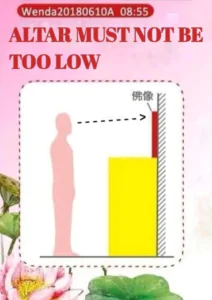
< Designing and arranging a Buddhist Altar >

Wenda20130714 00:36 (Master Jun Hong Lu’s call-in radio program – an excerpt)
A. An open altar
This is the suggested style
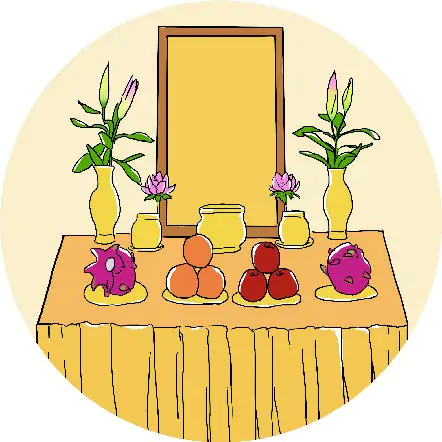
B. An enclosed altar
When conditions don’t allow, say, if the environment is messy or if the altar is close to the kitchen or a couple’s room due to space constraints, it’s recommended to use an enclosed altar with a curtain or cabinet door. Open the curtain or the cabinet door when making incense offerings.

Different styles of bases underneath the images/statues of Bodhisattvas
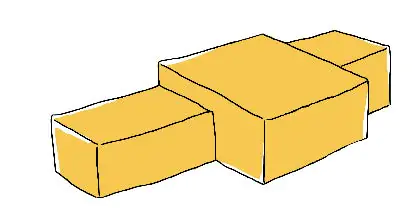
– T-shaped;
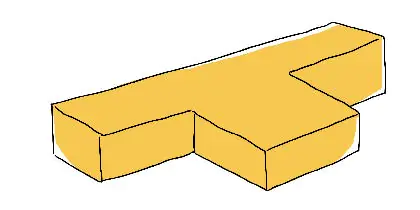
– Bar-shaped.
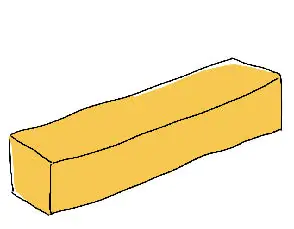
Types of cloth used on an altar (for references only)
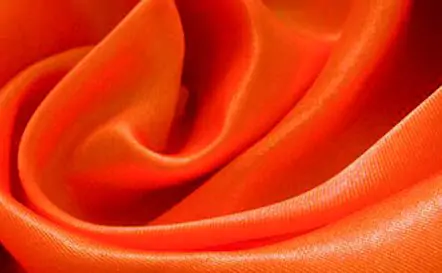
Wenda20140126B 14:56 (Master Jun Hong Lu’s call-in radio program – an excerpt)
DO NOT USE STONE AS BODHISATTVA’S PLATFORMS ON THE ALTAR; USE WOOD INSTEAD
Stone belongs to the element of Yin and cannot be used it as the platform to support the Bodhisattva’s statue.
Wenda20111225 94:33 (Master Jun Hong Lu’s call-in radio program – an excerpt)
DO NOT WEAR PRAYER BEADS MADE FROM IVORY OR PLACE THEM ON AN ALTAR
Caller: My daughter’s friend just got back from Hong Kong and she bought me ivory beads. But I learnt that it’s not good wearing prayer beads made from animal teeth. What should I do?
Master Jun Hong Lu: Do not wear them.
Caller: Can I place them on the altar?
Master Jun Hong Lu: No.
Caller: Should I place them in the drawer?
Master Jun Hong Lu: Wrap them with a piece of red cloth.
Wenda20141005A (Master Jun Hong Lu’s call-in radio program – an excerpt)
A BUDDHIST ALTAR SHOULD ONLY BE USED TO MAKE OFFERINGS TO BUDDHAS AND BODHISATTVAS, NOT AUSPICIOUS ANIMALS
Caller: There are two lion statues made of ceramic on our altar. Is this appropriate?
Master Lu: How can you place animal statues on your altar?
An altar is dedicated for Bodhisattvas. Auspicious animals can’t be placed together with Bodhisattvas. A Buddhist altar can only be used to pray to Buddhas or Bodhisattvas, not auspicious animals.
Collection of Master Jun Hong Lu’s discourses (3) – an excerpt)
CRYSTALS AND DHARMA INSTRUMENTS ON AN ALTAR
Question: A practitioner has hung a five-coloured flag at home. What scriptures should they recite to remove it?
Answer: The same way as you would when removing a Dharma instrument from an altar. The five-coloured flag is also a type of Dharma instrument, but each Dharma instrument serves as an offering to a specific Bodhisattva. Therefore, Master Lu didn’t advise to place a lot of instruments on the altar. A feng shui master might suggest placing certain things at certain places, but feng shui changes all the time.
What is deemed to be good now may change next year. So to be safe, it is best not to place these Dharma instruments on the altar.
Question: What about a crystal ball with the Heart Sutra carved on it?
Answer: Best not to. Scriptures are very solemn and have an aura. Whereas crystals are transparent which attract spirits easily. It is not solemn to carve scriptures on a crystal ball. Therefore, it’s best not to place it on an altar. Also, feng shui stones, fossils and purple crystals are also not advisable to be placed at home.
Collection of Master Jun Hong Lu’s discourses (3) – an excerpt)
ALTAR CABINETS – SHELVES, MATERIAL AND COLOURS
Question: What kind of wood is best for an altar? Any requirements on the colour?
Answer: Not much. Generally, rose wood would be better but don’t use old wood. A lot of old wood contains spiritual energy and carries the Yin energy. Colour-wise, it’s not advisable to use a dark colour, as dark colours also carry the Yin energy and light colours carries the Yang energy.
Wenda20141121 01:18:29 (Master Jun Hong Lu’s call-in radio program – an excerpt)
CAN AN ALTAR BE STEPPED UP ?
Caller: Can an altar be stepped with different levels ?
Master Jun Hong Lu: Yes.
Caller: The Bodhisattvas’ images will be placed on the top layer, and incense burners will be placed on the lower layer. It’s easier to clean it this way.
Master Jun Hong Lu: That’s fine.
Zongshu20160128 35:16 (Master Jun Hong Lu’s call-in radio program – an excerptSurrounding environment
Inappropriate books placed near an altar will produce negative impact
Caller: Master, according to your requirements, is my altar okay?
Master Jun Hong Lu: Not bad but I can see that it’s a bit messy underneath the altar. It’s not very good.
Caller: There’s nothing there, it might be the space next to it.
Master Jun Hong Lu: Yes, very dirty.
Caller: I’ll need to tidy it up. Those are books.
Master Jun Hong Lu: You need to tidy it. If there are inappropriate contents in the books, you will be in trouble.
Caller: Okay, I’ll remove them.
Zongshu20160128 35:16 (Master Jun Hong Lu’s call-in radio program – an excerpt)
QUESTION REGARDING THE LANDSCAPE PAINTING
Do not frame the landscape painting. A blessed landscape painting has no boundary.
Once it is framed, its energy will be limited.
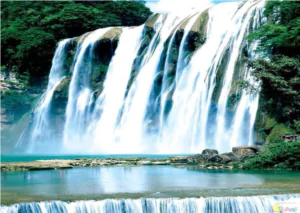
Wenda20161216 51:08 (Master Jun Hong Lu’s call-in radio program – an excerpt)
ORIGIN OF THE YELLOW LANDSCAPE PAINTING
Master Jun Hong Lu: You can’t find this landscape anywhere in the world. I sat next to a designer and told him how to create it on a computer step by step.
I could see the mountain in Heaven, and I instructed him to paint it. You won’t find this landscape in the Human Realm. It’s nowhere to be seen.
This landscape painting contains enormous power from Guan Yin Bodhisattva. It embodies both the Yin and Yang energy. Water is Yin and the mountain is Yang. This image harmonises the Yin and Yang. Hanging this landscape image at home would produce great energy.
It’s best to position the head of Guan Yin Bodhisattva’s image or statue in the halo above the mountain.
Wenda20130714A 02:33 (Master Jun Hong Lu’s call-in radio program – an excerpt)
THE YELLOW LANDSCAPE PAINTING CAN ONLY BE PLACED BEHIND THE ALTAR
Caller: Master, you advised us that the yellow landscape painting can only be placed behind the altar.
Master Jun Hong Lu: Yes. The yellow landscape painting can only be placed behind the altar like in Guan Yin Citta Practice Centre and not anywhere else in the house. Its function is totally different. The blue landscape painting can be used to adjust feng shui but the yellow one is a sacred scene. A practitioner hung it elsewhere and saw a lot of Bodhisattvas in the image. In fact, this is not respectful.
Why is it best to place this painting behind the altar? This painting is very majestic. The mountain is spectacular and has been blessed by the Bodhisattvas of Guan Yin Citta Dharma Door.
Once the mountain is blessed, it will have spiritual energy, gaining a special aura. That’s why it is very beneficial to place it behind the images or statues of Bodhisattvas, making it easy for Bodhisattvas to come and go.
Caller: I understand.
Wenda20130712 04:35 (Master Jun Hong Lu’s call-in radio program – an excerpt)
THINGS TO WATCH OUT FOR WHEN STICKING THE YELLOW LANDSCAPE PAINTING
Caller: I want to invite the Bodhisattvas off the altar temporarily so that I can stick the landscape image to the wall. Is there anything I should pay attention to?
Master Jun Hong Lu: Do it only when the incense and the oil lamp are extinguished. You should also keep reciting the Heart Sutra during the whole process.
Caller: After offering morning incense, I’ll recite the Heart Sutra while inviting Bodhisattva’s images off the altar after the incense is fully burnt. Is it okay if I clean these images as well? (Yes.)
Wenda20130818B 59:18 (Master Jun Hong Lu’s call-in radio program – an excerpt)
LIGHTING IN THE BUDDHIST HALL
Avoid using incandescent light or having a chandelier above the image of Bodhisattvas
Caller: Master, please take a look at my altar.
Master Jun Hong Lu: It’s pretty good, but the overall colour is too white. (Why?) It’s not good if the colour is too white. It attracts spirits easily. You should change to a yellow tablecloth. (It is yellow.) How come it looks white to me?
Caller: There’s a problem. The altar looks too dim even though it’s by the window. I placed a lamp on the altar to brighten it up.
Master Jun Hong Lu: Is it an incandescent light? (Yes, it is cool white.) That’s no good. Change it to a warm light. No wonder the altar looks white to me, like snowy white.
Caller: There’s a chandelier above the altar, too.
Master Jun Hong Lu: Don’t place a chandelier above the images or statues of Bodhisattvas. The lighting should only come from the front.
Caller: Is everything else okay?
Master Jun Hong Lu: Yes, the rest is fine. Be cautious of the decorations.
Change the incandescent light as soon as you can or else it will attract spirits. Warm light is called Yang light, whereas incandescent light is also called Yin light.
Wenda20140105A 28:27 (Master Jun Hong Lu’s call-in radio program – an excerpt)
THE LOTUS LAMPS SHOULD BE SWITCHED OFF WHEN INCENSE ISN’T BURNING
Caller: Can the lotus lamps on the altar be switched on when incense isn’t burning?
Master Jun Hong Lu: No. Once the lotus lamps are on, you need to light up the incense. Once the incense is finished burning, the lamps should be switched off straightaway. Lotus lamps are used to invite Buddhas and Bodhisattvas.
Caller: If that’s the case, can the lights in the Buddhist hall remain switched on?
Master Jun Hong Lu: Yes.
Wenda20120629 56:10 (Master Jun Hong Lu’s call-in radio program – an excerpt)
THE LAMPS ON AN ALTAR CAN’T BE ON 24 HOURS A DAY
Caller: Can the lamps on the altar be on 24 hours a day?
Master Jun Hong Lu: The lights in the Buddhist hall in your house can be but not the lotus lamps on the altar.
Bodhisattva’s Blessing on setting up an Altar
With a Buddhist Altar set up at home, the family members will be blessed by Bodhisattvas; things have become smoother and whole family is safe and sound.
< How to make offerings to Bodhisattvas? >
Master Jun Hong Lu’s Dharma Talk on Metaphysics in Sydney, Australia, 9 May 2010 – an excerpt)
THINGS TO PAY ATTENTION TO WHEN PAYING RESPECT TO BODHISATTVA
When paying respect to the Buddhas, offering flowers will make us look prettier, and offering oil is good for our eyesight and for gaining wisdom. Some wise people suggest children spend their pocket money in buying a bottle of oil as an offering to Bodhisattva and to pray for more wisdom. Offering water can ease and calm our mind while also helping us eliminate greed as water doesn’t cost anything. Many people are attached to the offerings made to Bodhisattva.
A novice Buddhist practitioner will feel secure once they offer water to Bodhisattvas. Their mind will be as pure as water. Therefore, if one prays for a sense of security, it’s best to offer water. Water offered on the altar needs to be changed every day.
Furthermore, fruit offerings could help you to achieve what you wish for at a sooner time.
For example, if you pray for a smooth career path or job security, offering fruits such as oranges and apples could speed things up, so you’ll get the outcome sooner. For kind people, offering fruit would accelerate what they wish for.
For evil people, even though they make fruit offerings, karmic retributions come due earlier, too. The severity of the karmic retributions would be reduced if they come earlier, which is better than suffering harsh retributions at a later stage. This is the law of cause and effect.
Master Lu’s Discourse in Guan Yin Hall, Singapore, 16 January 2016 – an excerpt)
THE BENEFITS OF A BLESSING CEREMONY OF AN ALTAR
(佛台开光仪式)- What does blessing an altar mean?
From a religious point of view, to bless an altar means to endow Bodhisattva’s special energy in Bodhisattva’s images, statues and Dharma instruments. This is to guard and protect the sacred items. What is a ‘sacred items’? It’s the Buddha’s sacred image or statue. The deeper meaning of this is to get closer to our inner heart. When you speak about blessing, it’s not for you to bless Bodhisattvas; rather, it is to brighten the Buddha light in your heart.
After that, wisdom will emerge in your mind and remain in the Buddha images and the Buddhist instruments you want to bless.
Before blessing, these items are the same as any other items. They have no spiritual energy or brightness as they are contaminated by this mundane world. Their energy is concealed and hidden.
Consecration aligns our mind to the Buddha’s heart, to align the innate Buddha nature in our mind to the Buddha on the altar, and to align with the tremendous energy of the Buddha in the universe.
Shuohua20161014 19:12 (Master Jun Hong Lu’s call-in radio program – an excerpt)
THE EFFECTIVE ENERGY OF BLESSED IMAGES
Caller: Hello Master. You advised us that a blessed landscape image would be effective for five years. After five years, the energy field will diminish. Does this apply to the blue or the yellow landscape image, or both?
Master Jun Hong Lu: Generally, it applies to both. But for the yellow landscape image, it’ll be effective even after five years has passed. As long as Bodhisattvas visit your altar, the mountain will be immersed in the Buddha’s light.
For the blue landscape image, as it’s not placed behind a Bodhisattva, over time the energy will diminish, especially after five years.
When I bless the Bodhisattva’s image or statue, they are enveloped with energy, but over time the energy will be gone.
Caller: For Bodhisattva’s images or statues blessed by Master, will they be less effective if they are not on the altar within five years?
Master Jun Hong Lu: They won’t be effective after 2-3 years. After being blessed, never leave it for two years or more.
Wenda20160325 45:42 (Master Jun Hong Lu’s call-in radio program – an excerpt)
A BLESSED LANDSCAPE IMAGE CAN STOP SPIRITS FROM ENTERING
Caller: Master, can a blessed landscape image stop spirits from entering?
Master Jun Hong Lu: Definitely. Otherwise, what’s the point of having a landscape image? If you hang it on the door, wild spirits can’t enter your house. It’s very straightforward.
Wenda20140413B 18:17 (Master Jun Hong Lu’s call-in radio program – an excerpt)
QUESTIONS REGARDING BODHISATTVA’S IMAGES
Bodhisattva’s images that are not yet put on an altar need to be wrapped with red cloth and placed on clean surfaces. Avoid placing them on stools or chairs.
Caller: A practitioner plans to set up an altar in her new home. She hasn’t moved yet, so she has been putting the Bodhisattva’s image on a chair. Is this okay?
Master Jun Hong Lu: No! Chairs are for people to sit on. The image needs to be placed on a clean surface such as a table. Never place it on chairs.
Caller: I see. Place the image flat?
Master Jun Hong Lu: Yes. It’s inappropriate to place Bodhisattva’s images on the chair. This is disrespectful. It’s not okay even if it’s a brand new chair.
Caller: Is it okay to place the image in a red bag and keep it flat without wrapping it with red cloth?
Master Jun Hong Lu: It’s best to wrap it.
Wenda20160115 11:26 (Master Jun Hong Lu’s call-in radio program – an excerpt)
FRAMING OF THE BODHISATTVA’S IMAGE
The frame can be made of wood, aluminium alloy or polymer materials. Avoid using silver-coloured frames.
Caller: Master, I can see that the frames used for Bodhisattva’s images are usually made of wood and of golden colour. Is it okay if the frames are made of aluminium alloy?
Master Jun Hong Lu: Yes, both are okay but don’t use silver-coloured frames.
THE SIZE OF GUAN YIN BODHISATTVA’S STATUES AND IMAGES
Bodhisattva’s statues made of ceramic
Height (cm): Small (58), Medium (83)
Bodhisattva’s images (paper based)
Height & width (cm):
A2 (59.4 x 42); A3 (42 x 29.7);
A4 (29.7 x 21); A5 (21 x 14.8)
(The above is for reference only. Actual sizes may differ.)

Wenda20140815 07:55 (Master Jun Hong Lu’s call-in radio program – an excerpt)
Caller: Hello Master, what if the statue of Guan Yin Bodhisattva has a few broken fingers?
Master Jun Hong Lu: Wrap the statue and replace it with a new one. It is not respectful to pray to the statue of Bodhisattva with broken fingers.
Caller: Okay, what should I do?
Master Jun Hong Lu: You need to recite the Great Compassion Mantra 7 times, the Heart Sutra 7 times and the Eighty-Eight Buddhas Great Repentance 49 times.
Before reciting, say ‘Gratitude to all the helps and blessings that (the name of the Bodhisattva) has given to my family and I, (your full name). My gratitude to [name of Bodhisattva], my gratitude to [name of Bodhisattva]’. You must not say, “I’m inviting the Bodhisattva off the altar.”
Caller: How about Little Houses?
Master Jun Hong Lu: Yes, 21 Little Houses.
Caller: Should I take it to the temple?
Master Jun Hong Lu: Yes.
Wenda20160226 30:47 (Master Jun Hong Lu’s call-in radio program – an excerpt)
STEREOMETRIC BODHISATTVA STATUES HAVE MORE ENERGY THAN IMAGES
Master Jun Hong Lu: Stereometric Bodhisattva statues are definitely better than images. They receive energy easily, whereas an image can only receive a little energy. Why do the spirits we see is like a thin slice? (Yes).
Spirits are transparent. They are thin slices; therefore, they can only absorb Yin energy. Bodhisattvas in Heaven carry a great deal of energy. Therefore, stereometric Bodhisattva statues can be filled with positive energy easily.
< ACCESSORIES REQUIRED FOR BUDDHIST ALTAR >
How to Set Up a Buddhist Altar?
< PROCESS OF SETTING UP AN ALTAR >
Step-by-step Guide on How to Set Up a Buddhist Altar
STEP 1 – USING BOTH HANDS, RAISE EACH OF THE BUDDHIST ALTAR ACCESSORIES SLIGHTLY ABOVE YOUR HEAD BEFORE PLACING THEM ON THE ALTAR
- Statues/images of Bodhisattvas. The numbers shown below represent the sequence in which the statues/images are to be respectfully placed on the altar from your perspective: ③ Tai Sui Bodhisattva ② Nanjing Bodhisattva ① Guan Yin Bodhisattva ④ Guan Di Bodhisattva (Guan Ping Bodhisattva, Guan Di Bodhisattva, Zhou Cang Bodhisattva)
- Place the incense burner(s) correspondingly
- Oil Lamps
- Fruits
- Fresh flowers
- Cups
STEP 2 – RESPECTFULLY INVITE
- Light up the oil lamp. If you have an electrical lotus lamp, turn it on prior to lighting the oil lamp.
- Light up the incense (use the oil lamp to light up 3 incense sticks and in a vertical position, raise it up above your eyebrows and bow 3 times. Place the 3 incense sticks (all at once) into the incense burner. The tip of the incenses should not point towards the direction of Bodhisattva.
- Light up the “big incense” (sandalwood stick) – 3 times. This is to be done on the special days of Buddhas and Bodhisattvas. After lighting up the oil lamp and incense, light up the sandalwood stick using the oil lamp, and extinguish the fire (do not blow using your mouth) – the smoke generated is referred to as the “big incense”, the fragrance of Bodhisattva. You may repeat this action 3 times.
- Kneel in front of Bodhisattva.
- Sincerely invite (each Bodhisattva 3 times)
- State the following prayers:
- “Sincerely invite the Greatly Merciful and Greatly Compassionate Guan Yin Bodhisattva enter the image of Bodhisattva enshrined by me, XXX”.
- “May the Greatly Merciful and Greatly Compassionate Guan Yin Bodhisattva invite Nanjing Bodhisattva to enter the image of Bodhisattva enshrined by me XXX.” Recite 108 times of the sacred name of Nanjing Bodhisattva.
- “May the Greatly Merciful and Greatly Compassionate Guan Yin Bodhisattva invite Tai Sui Bodhisattva to enter the Bodhisattva’s image enshrined by me, XXX”. Recite 108 times of the sacred name of Tai Sui Bodhisattva; 21 times of the Xiao Zai Ji Xiang Shen Zhou.
- “May the Greatly Merciful and Greatly Compassionate Guan Yin Bodhisattva invite Guan Di Bodhisattva, Zhou Cang Bodhisattva and Guan Ping Bodhisattva to enter the Bodhisattvas’ image enshrined by me, XXX”. Recite 108 times of the sacred names of the Bodhisattvas.
- (Note: If the Bodhisattvas’ images enshrined have been consecrated by Master Lu, they may be enshrined directly onto the altar and the above recitation step can be omitted.)
- Complete the ritual by reciting 7 times of the Great Compassion Mantra, 7 times of the Heart Sutra.
- Perform kneeling prostrations; generally once to each Bodhisattva, a total of 7 prostrations.
STEP 3 – AFTER WHICH MAKE YOUR PERSONAL VOWS OR WISHES
- Vows: Refrain from the act of killing, practise vegetarianism, offer day and night incense, help others to be awakened spiritually, sponsor the printing of scripture booklets, make copies of CDs (the vow is to be made based on individual’s determination and circumstances). As the state of mind of every person differs, one should assess one’s capabilities and act accordingly, as such there is no one vow that can be made universally.
- Make a prayer request. Based on one’s circumstances, make reasonable prayer request(s), for example, you may pray for good health, smooth-sailing career, harmonious family, etc.
STEP 4 – PERFORM THE ACT OF PROSTRATION IN GRATITUDE
Lastly, thank all Buddhas and Bodhisattvas by performing 7 prostrations and recite the below prayer:
“Deepest gratitude to The Greatly Merciful, Greatly Compassionate Guan Yin Bodhisattva”;
“Deepest gratitude to Namo Nanjing Bodhisattva; deepest gratitude to Namo Tai Sui Bodhisattva; deepest gratitude to Namo Guan Di Bodhisattva, Namo Zhou Cang Bodhisattva and Namo Guan Ping Bodhisattva (and all Bodhisattvas that you may have enshrined).;
“Deepest gratitude to all Buddhas, Bodhisattvas and Dharma Protectors.”
AUSPICIOUS DAYS FOR SETTING UP ALTAR
AUSPICIOUS TIME:

< Buddhism in Plain Terms < 白话佛法共修分享
